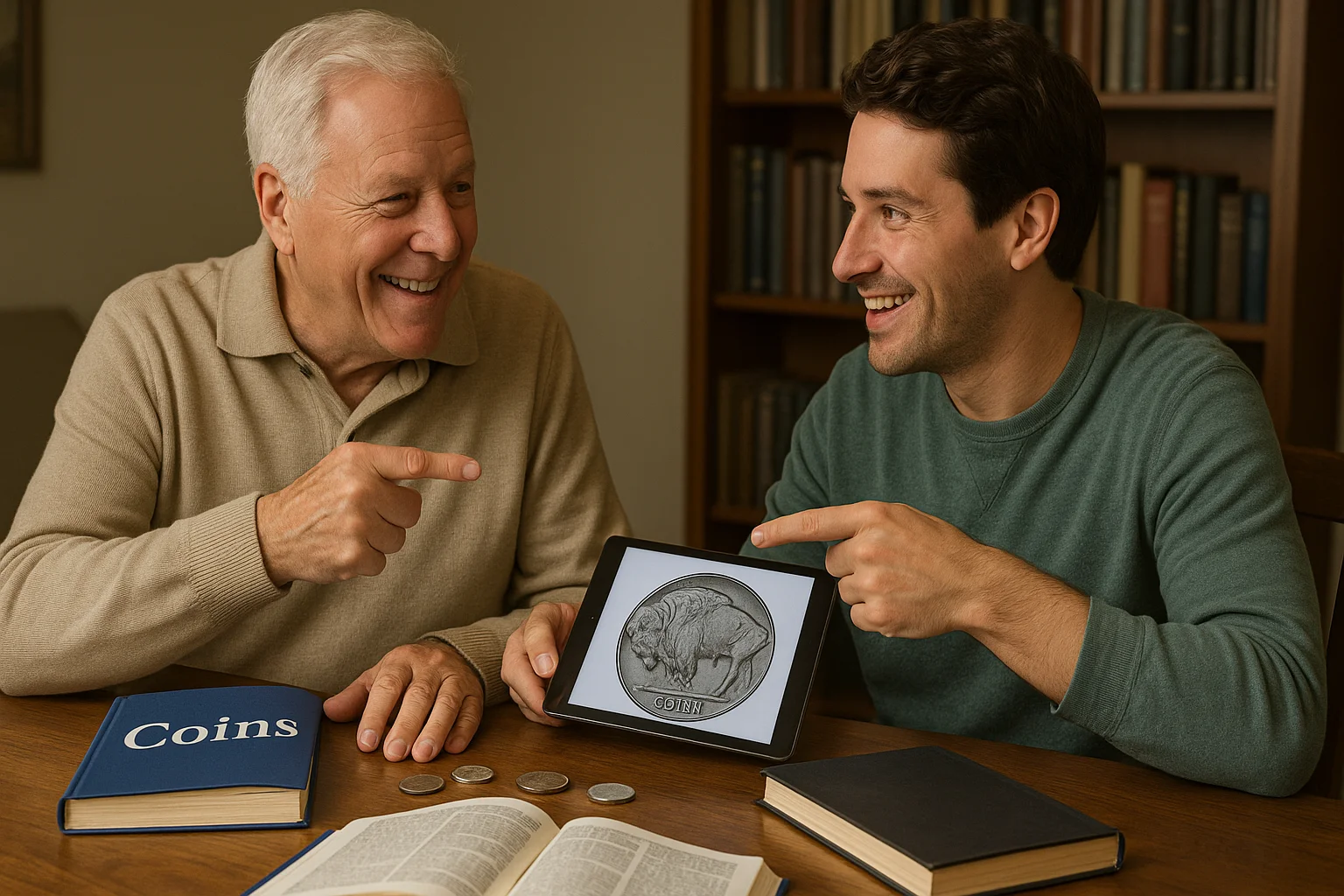There’s something oddly satisfying about the first time you stumble across an old coin — maybe it is a Buffalo nickel, a wheat penny, or a tarnished silver quarter that just feels different. That moment often sparks a thought: Is this worth anything? Could this be rare? That is where the adventure begins — and where the Red Book becomes your best companion.
What is the Red Book, Really?
First published in 1946, the Red Book — officially known as A Guide Book of United States Coins — has helped generations of collectors identify, learn about, and value their coins. It’s updated annually and includes virtually every U.S. coin ever made for circulation, from the colonial era to today.
It was written by R.S. Yeoman, a legendary name in numismatics, and is now edited by Jeff Garrett — another respected expert in the field. And no, it’s not just a price guide. It’s a full-on educational reference packed with history, coin specifications, mintages, and even notes on varieties and errors.

Why It Matters (Even if You Are Just Starting Out)
What makes the Red Book so helpful — especially for beginners — is how easy it is to use. Coins are organized by type and denomination (cents, nickels, dimes, quarters, etc.), with large, clear images and current retail price estimates based on grade.
You don’t need to be a professional collector to use it — in fact, that’s kind of the point. Many people grab a copy just to check out old family coins or sort through pocket change.
Here’s what you’ll find inside:
- Full-color photos of each coin type
- Mintage numbers (how many coins were made each year)
- Estimated values in multiple conditions (Good, Fine, Mint State, Proof)
- Special sections on error coins, commemoratives, and proofs
- Historical context that adds meaning beyond just the price
Want to get more out of your Red Book? Then, you should know a few simple tricks. First of all, you can use highlighters or sticky notes to mark coins you own or want to find. Then consider keeping older editions — they become collectible themselves over time. Additionally, use it as a checklist to track what is in your collection and combine it with magnification and basic grading knowledge to spot undervalued coins.
Many professional collectors swear by the Red Book — not just as a tool, but as a tradition. It is often passed from one generation to the next, filled with handwritten notes and family discoveries.
The Power of Digital – How Coin ID Scanner Expands What the Red Book Starts
Once you’ve spent some time flipping through the Red Book, highlighting coins, marking favorites, and cross-checking your pocket finds, you begin to feel a sense of control. You are not just guessing anymore — you are researching, learning, growing. But in today’s fast-paced, mobile world, even the best books can benefit from a modern companion.
That is where Coin ID Scanner comes in — not to replace the Red Book, but to continue what it starts.
From Print to Pocket: A Natural Next Step
Think of the Red Book as your foundation. It offers history, pricing, and structure — something every collector needs. But what happens when you are away from your desk? When you find a coin in the wild and don’t have time to look through pages?
This is where Coin ID Scanner becomes your go-to tool. All you need to do is just a few taps on your smartphone, and then the appwill do all the work: you can receive detailed information about it. It identifies the coin, estimates its value, and even checks for known error varieties — all within seconds.
You could say it is like having the Red Book’s brain, connected to live data, right in your pocket. How to use the Coin ID Scanner like a pro? Not a big deal: Coin ID Scanner is designed to be simple, even if you’re brand new to collecting. Below are the quick steps to getting the most out of it:
- Take a clear, well-lit photo of the coin’s front and back. A neutral background works best.
- Let the app analyze the image and match it with its massive database.
- Review the results — including coin name, year, mint mark, metal content, grade estimate, and current market value.
- Save the coin to your personal digital collection within the app, so you can track your finds and build your portfolio.
Collector’s tip: For error coins (like double dies or off-center strikes), use the zoom feature and compare with sample images the app provides. Then, cross-check with the Red Book’s error listings for confirmation.
Key Benefits of the app:
- Real-time pricing from auctions and market listings
- Access to thousands of U.S. and world coins, including obscure ones
- Quick identification — great for garage sales, flea markets, or shows
- Inventory feature to track your collection digitally
- Error detection help, including rare varieties
- Perfect for beginners who might not recognize certain coins on sight
So, whether you are building a collection or looking to invest, this tool gives you an edge — saving you time, avoiding mistakes, and sometimes helping you spot something rare before anyone else does.
What are the Real-World Scenarios where Coin ID Scanner shines? For example, you’ve found a mystery coin in grandpa’s jar? Scan it instantly. You are at a flea market and spot an old nickel? Check if it is a valuable wartime issue. Are you comparing two Lincoln cents? Let the app highlight potential doubling or mint mark errors. With a single tap, what used to take hours of research can now be confirmed within seconds — and with surprising accuracy.
Red Book vs Coin ID Scanner: How to Choose?
It’s a question that pops up often in coin collecting circles: “Do I really need both the Red Book and Coin ID Scanner?” And the answer isn’t about choosing one over the other — it’s about understanding what each tool brings to the table. Let’s break it down.
Side-by-Side Comparison: Red Book vs Coin ID Scanner
| Feature / Function | Red Book | Coin ID Scanner |
| Historical insights | Detailed coin histories and background | Also provide details and historical background |
| Pricing | Static (updated yearly) | Dynamic, live pricing from real-time data |
| Coin identification | Manual, based on knowledge and visuals | Automatic via photo recognition |
| Portability | Book format – less portable | Fits in your smartphone |
| Error coin detection | Descriptions and notes on known errors | Smart image-based error identification |
| Collection management | Not included | Save, track, and manage your coins digitally |
| Learning depth | Structured educational content | Focused more on results, not theory |
| Best for | Traditional collectors, researchers | Beginners, mobile users, fast evaluations |
Use Both, Level Up Faster
In truth, the smartest collectors don’t choose — they combine. They read and study with the Red Book to build their foundational knowledge, and then use Coin ID Scanner to act quickly and accurately in the real world.
Here is how the synergy works:
- See a coin at a flea market? Scan it with Coin ID Scanner to check for rarity.
- Want to know if a coin in your collection is worth grading? Use the app, then check the Red Book for background and auction history.
- Studying coins at home? Then you can use the Red Book to expand knowledge, and the app to compare your knowledge with real-world examples.
It’s not a battle — it’s a partnership.

Turning Pages, Tapping Screens – Mastering the Hobby with Smart Tools
Coin collecting has come a long way from dusty bookshelves and magnifying glasses. But it hasn’t abandoned them — it’s improved them. Due to blending the time-tested authority of the Red Book with the power and precision of Coin ID Scanner, collectors can now navigate both past and present like never before. So don’t pick sides and use both — learn with the Red Book and act with Coin ID Scanner. And watch your collection — and your knowledge — grow together.
